The world of Magic: The Gathering isn’t just a card game; it’s a universe of strategy, lore, and for some, profitable collectors’ items. Whether you’re meticulously archiving each Black Lotus variant or just having fun with your friends, there’s a shadow lurking that can flatten your enthusiasm quicker than losing all your creatures to a board wipe: counterfeit cards. As counterfeiters grow more resourceful, mastering the age-old sleight of hand art, collectors must evolve into magicians in their own right, proficient in the art of spotting an imposter. Fear not! Here’s your enchanted guide to unmasking the pretenders masquerading as your cherished treasures.
Let’s start with the most basic — your senses. Trust them implicitly. It’s all about the feel, the weight, the smell (okay, maybe not the smell unless you’re in a particularly sniffy mood), and even the sound. Genuine Magic cards possess a certain undeniable texture — like a veteran of the cardboard wars, they’re matte, tactile, velvety, and substantially different from slick and glossy interlopers. If it feels more like the menu at a takeaway restaurant than a battle-worn card, you might have a problem brewing in your collection. The simplest test? Grab a land card from the same set and compare. When in doubt, draw them both out!
But let’s illuminate things further with the elegant dance of light. An often overlooked trick involves giving your card a gentle yet probing embrace with a flashlight. Real Magic cards are like the heroes of their stories — complex yet clear, with a signature blue core nestled between layers, yielding a soft, cool light. Counterfeit cards might crash the plot with their thoughtless disregard for subtlety, showing as either stubbornly opaque or overly eager to illuminate — too bright, too thin, and regrettably washed out.
Enter the jeweler’s loupe. This isn’t just a tool; it’s your miniaturized Crystal Ball, a seer into the world of dot patterns. At 30x magnification, it’s like standing on the shoulders of Magic giants. Authentic cards reveal a meticulous rosette pattern formed by tiny dots dancing together — art and text celebrating authenticity. Counterfeits? They show themselves much like lazy pixelations on a screen, shaky grids, or smudged half-truths hoping you overlook them.
On to the next magician’s trick — the “Solid Black Test.” Magic cards use solid black ink for elements like names and mana symbols, so under magnification, it will appear rich and definitive. Counterfeit cards will often betray themselves with a muddy assembly of colored dots trying too hard to be bold but failing spectacularly.
Then there’s the enigmatic Green Dot or the “infamous green dot L” as it’s been monikered among aficionados. Flip to the back of your card and train your eyes on the green mana symbol. Look at the yellow-green border and spot a red dot constellation forming an upside-down ‘L.’ If it’s a cluster of mysteries — misaligned, blurry, or missing — then your card might just be one of those mirage mirth-makers.
Yet, in the ever-expanding tapestry of Magic, 2015 brought a new kind of enchantment — the holofoil stamp for rares and mythics. A true stamp isn’t merely an image; it’s flush with the card, embedding microtext like mana icons and planeswalker symbols into its fibers. Get your eyes closer to fake ones, and they might look akin to color copier emigrations — grainy, raised, or suspiciously akin to a sticker affixed by an overeager child.
But, a word of caution, like any wise planeswalker knows: do not indulge in destructive testing. Don’t tear and bend your cards trying to reveal the mystical blue core or risking revealing a grim “aha” moment that may lead to more harm than good. Modern counterfeiters have wised up, cloaking their creations with new-age spells that withstand these trials better than the originals.
Identifying a counterfeit, like a good Magic strategy, involves layering techniques and considering all gathered intelligence. Relish in the tactile exploration, observe with light techniques, inspect with magnification, and scrutinize holographic precision. Over time, your skills will expand like the ever-growing Multiverse, and your collection will remain as untouchable as a well-played Hexproof card. Knowing what to look out for not only makes you a more astute collector but also contributes to keeping the game’s spirit alive and unspoiled.
Keep your hobby, your investment, your passion safe. And remember, even the most convincing counterfeits can’t replicate the love and dedication you weave into your collection.






